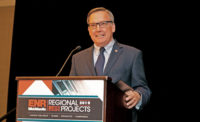Unprecedented grassroots campaigning by organized labor paid big dividends in the Nov. 7 elections. The AFL-CIO and its affiliates waged a nearly $40-million effort-a record amount for union spending in a mid-term election--to bolster Democrats and energize members to hit the polls.
 Sweeney
|
With control of the House in the hands of Democrats, AFL-CIO President John Sweeney vows to cash in on labor's investment and push what he terms "pro-working family" issues.
"Working people elected these men and women and we¹re not just going to hold them accountable we¹re going to unite our country behind them to renew economic opportunities for all," Sweeney said at a Nov. 8 press conference.

O'Sullivan
|
Laborers' International Union of North America General President Terence M. O'Sullivan says he was "elated" at the elections' outcome. In an interview with ENR, Sullivan said, "What I see with a Democratically controlled House...is the opportunity to start talking about infrastructure spending and making it a priority."
He adds, "The transportation infrastructure in this country has been crumbling," and contends that the issue has not received the attention it merits.
For organized labor more broadly, Sweeney says unions will demand that the new Congress take decisive action on key labor issues during its first days in session. Chief among those items are: a federal minimum wage increase; improvements to union organizing and bargaining power; giving Medicare the ability to negotiate for lower drug prices; restoring funding for college students; and ending rewards for companies that send jobs overseas. Sweeney also says he hopes to see a long-term effort to improve health care coverage options for all Americans.
The laborers' O'Sullivan also thinks that the shift in Congress provides "an excellent opportunity" for movement on a broad-based immigration measure, which would include a "guest worker" program. He notes that President Bush, who backs a "comprehensive" immigration measure, also said after the election that he sees improved prospects for such legislation.
AFL-CIO president Sweeney says, "With Nancy Pelosi (D-Calif.) as speaker of the House and George Miller (D-Calif.) leading the [House] labor committee we can take on the problems of working people."
Don Kaniewski, the laborers' political and legislative director, says, "We have had a long, long relationship with [Miller]" almost since he entered Congress more than 30 years ago. "He has been a champion for workers' rights," Kaniewski says. Besides pushing for a hike in the minimum wage, Miller also is expected to look at such other issues as pensions and health care, Kaniewski says.
With Democrats in charge of the House, he also expects there to be floor action on long-delayed Clean Water legislation. "Everybody knows Clean Water didn't come up because Republicans didn't want to take a Davis-Bacon vote that they knew they'd lose," Kaniewski says.
O'Sullivan says that one of the messages voters were sending in the elections was that "they're looking for results" from Congress. He says he's hopeful that there will be bipartisanship next year on Capitol Hill, and instead of "playing stall-ball," lawmakers will start moving "progressive legislation."
AFL-CIO research shows that this year its members voted more heavily for 74% of union voters supported union-endorsed candidates in the House. In 2004, roughly 70% of union members voted for union-endorsed candidates.
The AFL-CIO¹s program contacted 13.4 million voters in 32 battleground states. During the final four days of the campaign, nearly 187,000 volunteers made almost 8 million phone calls and knocked on 3.5 million doors.
The program focused heavily on "drop-off" voters who generally don¹t vote in mid-term elections, reaching out to them on average of 25 times during the campaign. The program reached 496,000 drop-off voters in Ohio alone. As a result, 79% of those drop-off voters did go to the polls and 76% of those for the Democratic candidates, according to AFL-CIO research.
 Related Links:
Related Links: 

Post a comment to this article
Report Abusive Comment